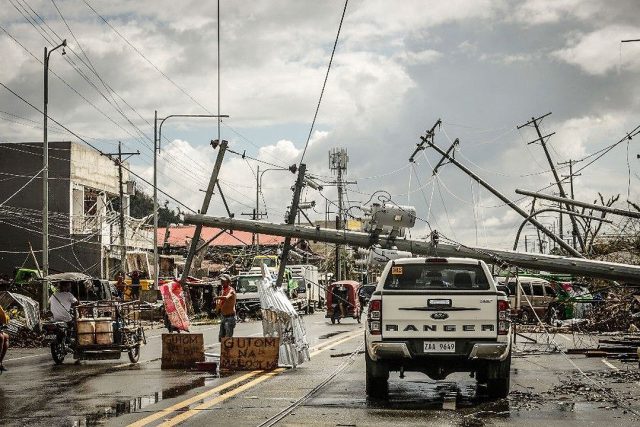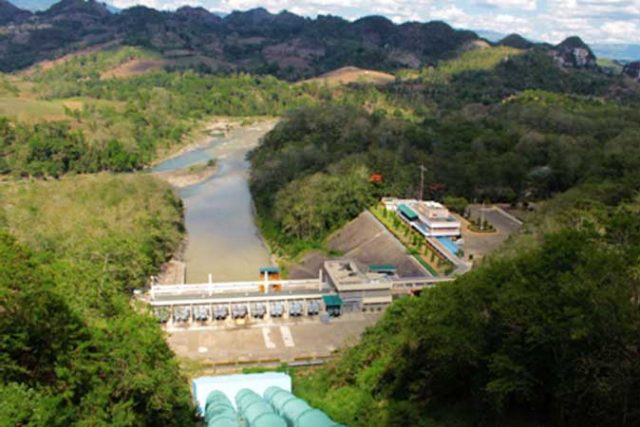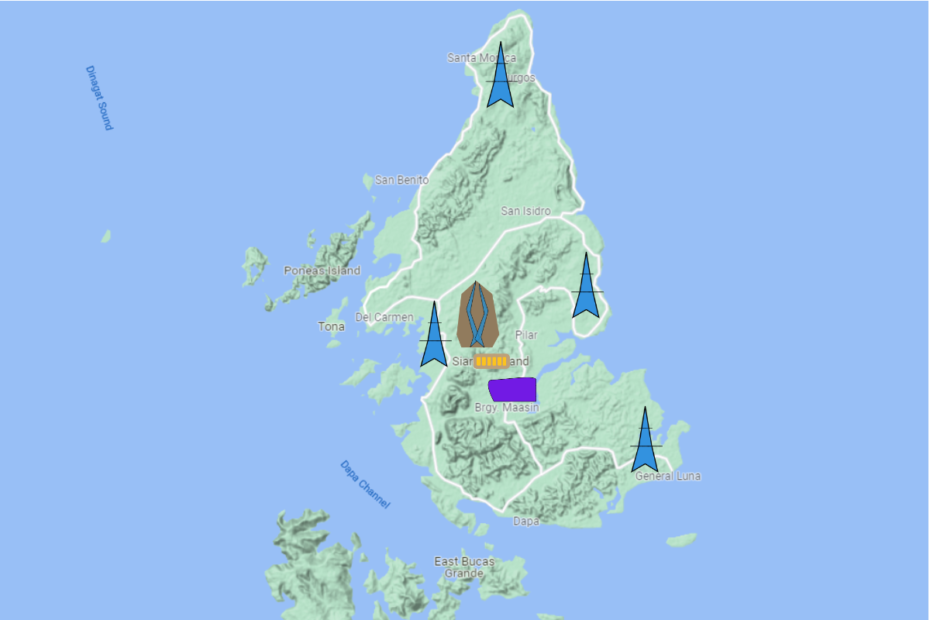On December 16, 2021, tropical typhoon Odette (international name “Rai”) hit Siargao Island directly, and caused immense damages to the island. The airport terminal was destroyed, electricity and telecommunication were down for weeks, many homes were leveled to the ground, and people suffered from water and food shortages for several weeks.
While noting the devastation that this typhoon has caused, one should be reminded of a saying: “no disaster should be wasted”, meaning that the disaster has shown us the main vulnerabilities of Siargao Island to vicious typhoons. Odette is unlikely to be the last of them. If we do something now, when these vulnerabilities are still fresh in our mind, maybe, just maybe, next time, Siargao island can be more capable of escaping major damages to people and properties.
Siargao island
Siargao island is a place that has been growing in prosperity in recent years because of tourism. Its popularity grew from its being discovered as an ideal surfing location. After that, more tourist attractions were found on the island.
Siargao island’s population is around 110,000. As its tourism industry grows, which it will, as it slowly recovers from Odette, population can be expected to grow fast, since it will be attracting residents from nearby islands because of its income generating opportunities brought by tourism.
This means several things:
– higher population will be affected in future disasters;
– higher income from tourism;
– higher demand for public utilities such as power, water, and waste management.
We need to plan and put in place facilities and systems now to mitigate these issues, so that the success of Siargao will not become its downfall in the future. The more we do now, the less we will lose in the future.
Typhoon vulnerabilities of Siargao island
Electricity
Siargao island has been without electricity since Typhoon Odette hit it on December 16, 2021. As of January 13, the website and social media of the electricity distributor in Siargao island, called SIARELCO, have no update. According to a press report published on December 26, 2021, the Placer-Madrid 69 kilovolt (KV) line affecting Siargao island, parts of Surigao del Norte and Surigao del Sur, had yet to be restored. (https://www.bworldonline.com/ngcp-restores-85-of-vis-min-transmission-lines-after-typhoon/)

Even when the transmission lines from Mindanao were repaired on December 31, 2021 (reported here), the distribution of electricity to Siargao island was not restored, due to the damages sustained by distribution lines located on Siargao island.
Siargao has an off peak electricity demand of 6.6MW and peak demand of 7.9MW in 2018. This was projected to increase steadily, to 10.5MW to 13MW in 2021, for example.
Siargao’s electricity is mostly supplied by the Mindanao grid of Power Sector Assets and Liabilities Management Corporation (the Agus-Pulangi hydro power complex and the Mt. Apo geothermal power plants) (6MW), Hydro Electric Development Corporation (HEDCOR) of Aboitz Group (Bukidnon Hydro power plant) (2MW), and 2 MW power from coal-fired plant in Kauswagan, Lanao Del Norte, Mindanao from GN Power.

Telecommunication
Siargao has telecommunication services provided by the two dominant telephone companies in the Philippines, namely PLDT and Globe. In 2019, Globe added three new cell towers to Siargao (see news here). Globe at that time, mentioned the difficulties to set up new cell towers due to bureaucratic red tapes.
The onslaught of Odette knocked out telecommunication, either due to damages to cell towers, or lack of power. One week after Odette, telecommunication was partially restored in Siargao island (read this).
Emergency shelter
In preparation for Odette, the authorities set up a newly completed sports complex to serve as evacuation center.
According to a Twitter message (Gretchen Ho), “This is what the Siargao sports center/evacuation area looks like. They were evacuated into the sports center but the sports center collapsed during the storm.” — Jeaneth Tuason (11:57am, December 20, 2021)
Water and food
The Metro Siargao Water District (MSWD) was formed on January 16, 1978 and provides potable water supply to the thirteen (13) poblacion barangays of the municipality of Dapa as its service coverage. Dapa is one of the nine municipalities on Siargao island. The present water supply is an underground creek with running water. https://mswddapa.gov.ph/?p=28
Even before December 2021, Siargao island seems to have a shortage in the supply of drinking water. This was mentioned in an Asian Development Bank (ADB) document, called “Communities lead the way in creating a more resilient Siargao Island” (https://www.livablecities.info/resilient-siargao-island).
In the aftermath of typhoon Odette, residents of Siargao were faced with a lack of drinkable water and food supply. Deaths caused by drinking dirty water were reported in the press. According to one report, this was due to the lack of electricity to operate water filtration systems.
A proposed Emergency Response Facility
Judging from the experience of Typhoon Odette, an ideal Emergency Response Facility for Siargao island should have at least:
- A local power source
- A power storage facility – battery pack.
- Underground power distribution cables
- Cell towers that have backup power for at least 7 days
- A secure water purification system with backup power
- A evacuation center that can withstand strong wind
Out of these items, a local power source is deemed the most important, since many of the communication facilities and water purification equipment only went out of service due to the lack of power.
Power source
We recommend building a renewable local energy source that can provide electricity that is equivalent to the power needs of 70 households. This is probably about the same as the electricity needs of:
– a large evacuation center, for cooking and lighting, plus
– a medium sized water purification system, plus
– three to four telcom cell towers.
Of the viable renewable power sources available, we think that a Vertical Axis Wind Turbine would best suit the situation of Siargao. Unlike the more photogenic Horizontal Axis Wind Turbine, A VAWT does not require a large space, or needs to be tall, and it works at a wider wind speed range.
A Philippine household on average uses 248 kWhrs per month, or about 3,000kWh per year. If we install a 4kW wind turbine(s), under reasonable assumptions of wind speed (90kmph) and 24 hours of wind a day, it can generate about 28,300 kWh per year, enough power for about 70 households, using data provided by one brand of VAWT (“Icewind”).
In fact, a test project using VAWT is already underway in Batanes (the Challenergy project funded by Japanese government).
Battery pack
We need a battery pack to smooth out the power generated by the wind turbine, as well as provide power even when the main power is out, and the wind turbine is not generating power.
The cost of a battery pack is directly proportional to the amount of power that it can store.
How big should the battery pack be? We do not know. Say it should have enough juice to meet the electricity needs of a large evacuation center, a water purification system, and support three to four telcom cell towers for ten days, assuming that is how long it will take the main power, or wind turbine power, to come back on, 28,312 kWh/12/3 = 786kWh. According to a report, the cost of a lithium battery power pack is estimated to be around USD135 per kWh. 135 x 786 = USD 106,170.
Youtube: https://youtu.be/y3NigkEeshU
Cost
We do not have actual cost information. A study needs to be conducted to determine the design and estimated cost of the different components of the project. We provide a guesstimate below just for the purpose of keeping the conversation going.
- Wind turbines (4kW) : USD 64,000
- import and transport the wind turbines : USD 40,000
- Installation of the wind turbines USD20,000
- Battery pack (786 kWhr) : USD106,170
- Building to house the battery pack : USD25,000
- Ground preparation for the wind turbines and battery pack building: USD20,000
- Underground cables to connect wind turbines to battery pack, evacuation center, cell towers and main grid USD50,000
- System design USD20,000
Estimated total cost: USD345,170. Cost of land acquisition is assumed to be zero as presumably there is government land available for this purpose.
Regarding the construction of a strong roof for the evacuation center, which normally serves as a sports center, the cost may have to come from the national government budget, who presumably built the sports center in the first place.
The cell towers that can withstand strong typhoon and to be designated as part of the emergency facility may be paid for by the telecommunication centers. The local government unit can help to expedite their construction or upgrading from existing cell towers by reducing the amount of red tapes that often delay such work.
Assuming that the cost of electricity (generation, transmission, distribution etc) in Siargao is P9 per kWh, and that after charging the battery pack fully, 80% of the electricity can be fed into the grid and sold to customers, then 28300×0.8×9/50 = USD4,075 per year can be recouped from the wind turbines.
Assuming a life of 15 years, this income can cover (15 x 4075 / 345170=) 18 percent of the project cost.(USD345,170)
To make this project a reality, we need to explore options to:
- Reduce cost
- Increase power output from the wind turbines
- Find alternative sources of income
- Look for grants that promote green energy and sustainability in developing countries.
On a per capita basis, the total project cost of USD345,170 will only cost per resident USD 3, since Siargao island has a population of over 110,000. However, due to the high level of poverty, most residents are unlikely to be able to pay for it.
Since an emergency power supply will give confidence to tourists to return to Siargao island, the most immediate beneficiaries of the facility would be those operating hotels on the island. It may be possible to persuade them to accept a surcharge on their electricity bill for a few years as a contribution to the project cost. This could potential provide for another 10% of the project cost.
The remainder of the project cost may have to come from donations from outside bodies, such as international organizations that support the development of renewable energy in developing countries.
Next step
Local authorities of Siargao island, with the support of local community, and friendly communities, such as surfer groups, are advised to work on a plan to build an emergency facility for Siargao island, using this concept paper as a starting point.
